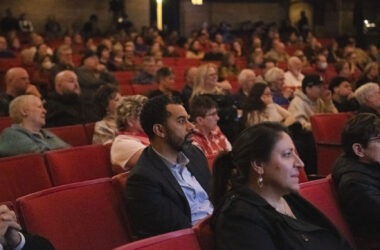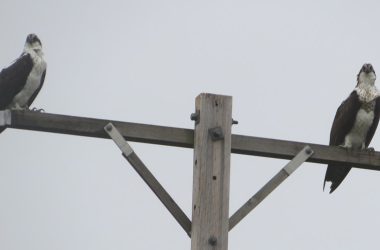When it comes to descriptions with the Ben Maxwell Collection, you can’t take them as gospel. Often, the information is correct but some of the details have been muddled or lost with time. This photo of the Christmas Nativity scene on the Capitol Mall, circa 1960, is no exception.

The original description was:
These life-size figures were set up in front of the Oregon State Capitol as a Christmas Nativity scene in December 1960 and 1961. The figures are thought to have been made by prison inmates. Because of controversy surrounding having a religious display on public property, it was moved to Willamette University campus after 1961.
In 1960, the Salem Area Chamber of Commerce made plans for an extensive Christmas display on the Capitol Mall.
Preliminary plans included a religious theme and extensive lighting of the trees in the mall. Chamber manager Stanley Grove told the Oregon Statesman for its July 31, 1960, issue: “If the Christmas program gets full support from the community and substantial funds are obtained, it will be the biggest Christmas lighting program ever staged in this area.” He also figured it would draw visitors from as far as 300 miles from Salem.
By October 1960, plans were full speed ahead. The Chamber’s Christmas Committee approved spending between $6,000 and $7,000 on mall decorations.
“A nativity scene, to help put ‘the true meaning’ back in Christmas would likely be the focal point,” the Oregon Statesman reported Oct. 13, 1960. “Officials said possibly the Mall project — endorsed by city, county and state officials — will replace downtown decorations this year.”
Differing reports put the cost of the 28 life-sized figures and two 14-foot-tall angels at $5,000-$6,000. A Capital Journal story sheds light on where the figures were built, and it was not at the Oregon State Penitentiary. “The Nativity scene will be comprised of life-size figures. On order from an eastern firm, they will be of rubber and plastic and will be guaranteed for 10 years,” the Capital Journal wrote Nov. 19, 1960. “The Nativity scene will be arranged on a platform 32 feet by 12 feet in size.”
From the beginning, there were concerns about having a religious display on the grounds of the state Capitol.
The Oregon Statesman reported on Dec. 13, 1960: “A letter challenging the constitutionality of the Christmas Nativity scene in the Capitol Mall was met with a Monday reply from Secretary (of State) Howell Appling Jr. pointing to a precedent in the annual erection on the White House lawn of a giant Christmas tree from Oregon’s forests.
“The letter from Civil Liberties President Charles Davis, Portland, ‘vitally concerned with the principle of separation of church and state,’ also contended that the first amendment of the U.S. Constitution requires the state ‘to be neutral in its relations with groups of religious believers and non-believers. To use the Capitol Mall for religious displays aids and endorses religion and religious teaching, which the State of Oregon is not permitted to do. By abstaining from endorsing or aiding religious principles of worship, the State of Oregon does not discriminate against religion but protects religion from state interference.’
“In his letter of reply, Appling added that ‘there is more than ample authority in tradition, in the precedents of a century, and, I dare say, constitutionality, for the use of the Mall for recognition of the existence of God during this brief season.'”
The display opened with Dr. Paul Poling, the pastor of the First Presbyterian Church, giving the invocation; and the Rev. Robert Hagen of St. Joseph’s Catholic Church giving the benediction.
The South Salem High School choir provided music after the lighting ceremony and Santa Claus distributed candy canes.
Music performances were a staple of the display for the early years.
Separation of church and state wasn’t the only issue supporters of the display had to contend with. Items from the display, including the baby Jesus and sheep, were stolen. A replica Jesus was placed in the Nativity scene for the rest of the 1960 display. The stolen items were found in Bush’s Pasture Park in June 1961. Thefts and vandalism continued to be a problem in future years as well.
The Chamber got support from inmates serving life terms at the penitentiary, a club called Lifers Unlimited, to repair and paint the figures beginning in 1969. There was discussion in the mid-1960s of painting them other colors. By 1970, it was decided instead to use colored lights on the figures.
The fear of a lawsuit about the display on public property prompted the Chamber group to rename itself the “historical tableau committee.” It wasn’t a lawsuit that prompted concerns about the future of the display, but weather.
On Dec. 28, 1970, high winds damaged some of the figures. Some were so badly damaged Chamber Manager Donald McNeil told the Oregon Statesman, “I don’t think the Lifers can put them back together.”
The tradition continued the following year, however, and the Lifers began installing the display at the Capitol Mall in 1971.
The Nativity scene’s last display on the Capitol Mall was in 1972. The following year, the Chamber of Commerce decided not to put up the display because of the energy crunch. The Oregon Statesman reported Nov. 21, 1973: “The lighted Nativity display would require spotlights, now not recommended, chamber president Malcolm F. Marsh said. Besides there are no street lights in the Capitol area now and vandalism would be a problem.”
That wasn’t the end of the Nativity display though.
In 1974, the Capitol Planning Commission had to give approval for continuing to allow the display on the Mall. When the OK wasn’t forthcoming, the Chamber accepted an offer from the Marion County Board of Commissioners to move it to the courthouse lawn.
By the mid-1970s, the separation of church and state issue continued to grow, but the tradition of the Nativity continued as well. County officials were steadfast in keeping the display.
On Dec. 20, 1978, a transient started a fire to keep warm in the manger portion of the display. The blaze destroyed the statues depicting Joseph, Mary, the baby Jesus, the crib, the manger and several bales of straw. The figures depicting the three wise men and several shepherds, angels and lambs weren’t damaged. The figures were insured, though.
It returned the following year, which would be the display’s last on public property. An agreement was made by the Chamber to place it on the grounds of Willamette University at Southeast State and Winter streets in 1980. The display continued until 1982.
What ended the Nativity display was age, weather and vandalism. The figures, which were guaranteed to last a decade when they were built in 1960, survived as long as they did thanks to the efforts of the inmates and the financial help of the Chamber. By the 1980s, the costs of replacement figures were becoming cost prohibitive.
The Ben Maxwell Collection consists of more than 5000 photographs donated to the Salem Public Library by the estate of Mr. Ben Maxwell, a noted Salem photographer and historian who died in 1967. Maxwell was a native of Salem, where he was born in 1898. He attended college at Oregon State University where he studied history and journalism. He started working with the Capital Journal newspaper in 1939. Because he packed his camera on every quest for historical stories, he was able to illustrate his articles for readers of the Capital Journal, the Oregon Journal, the Oregonian, and several magazines.
He recorded on film at least 13 governors, old-timers now gone, covered bridges now missing, and buildings and homes no longer standing. The collection includes copies of rare early Oregon photographs taken by others which have in turn been copied over and over by later researchers and feature story writers. This collection is a work in progress and many additional photographs remain to be scanned. The collection can be accessed at: https://photos.salemhistory.net/digital/collection/max
The City of Salem’s Historic Preservation Program staff within the Community Development Department in collaboration with the Salem Historic Landmarks Commission are in the process of completing an inventory of this collection and working to confirm and verify the content and narratives associated with all the photographs in this collection. Please contact Salem’s Historic Preservation Officer, Kimberli Fitzgerald at [email protected] with any suggestions, historic facts, or questions you might have about these historic photos.
STORY TIP OR IDEA? Send an email to Salem Reporter’s news team: [email protected].
SUPPORT OUR WORK – We depend on subscribers for resources to report on Salem with care and depth, fairness and accuracy. Subscribe today to get our daily newsletters and more. Click I want to subscribe!








